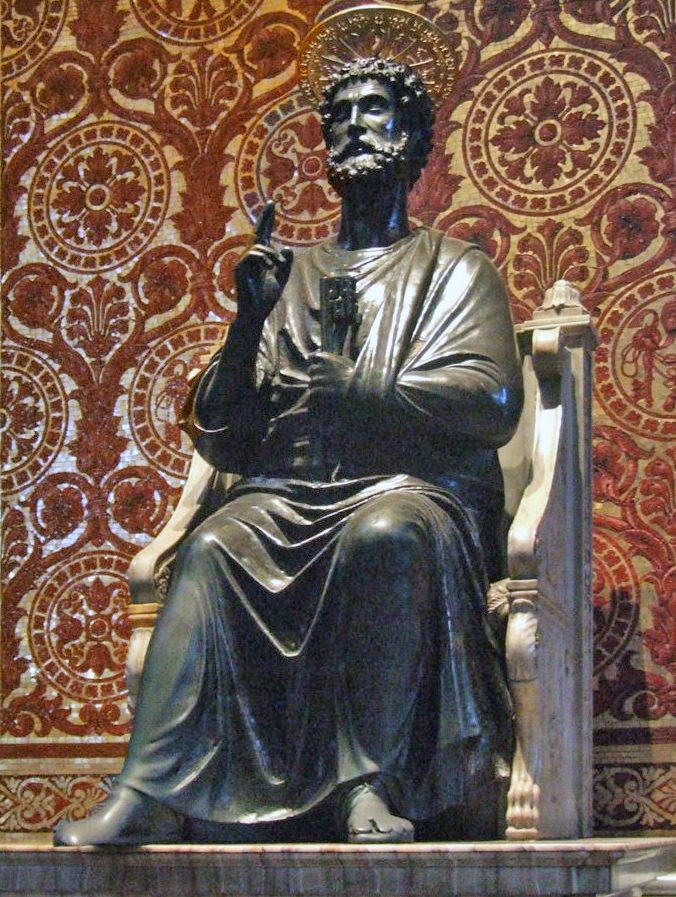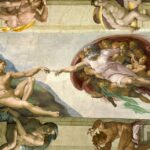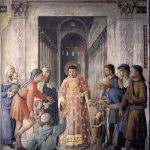
St. Peter’s Basilica is one of the most iconic buildings in the world. Known for its immense size and breathtaking architecture, this Roman Catholic church stands at the heart of Vatican City, drawing millions of visitors every year. While many people come to marvel at its grandeur, few realize that St. Peter’s is filled with hidden gems, legends, and artistic masterpieces that often go unnoticed. What makes this basilica truly fascinating is not just its imposing structure, but the intricate stories and secrets that lie within its walls.
The Origins and History of St. Peter’s Basilica
St. Peter’s Basilica was not always the architectural marvel we see today. Its roots trace back to a much humbler beginning, built over what was believed to be the burial site of St. Peter, one of Jesus’ apostles and the first pope. According to tradition, St. Peter was crucified upside down in Rome under the reign of Emperor Nero, and his remains were buried in a simple grave on Vatican Hill.
The first version of the basilica was commissioned by Emperor Constantine in the 4th century, around 326 AD, shortly after Christianity became the Roman Empire’s official religion. This original structure, known as “Old St. Peter’s Basilica,” stood for more than 1,000 years. Over time, however, the old basilica deteriorated, and by the 15th century, Pope Julius II ordered its complete reconstruction. This set the stage for the Renaissance masterpiece we know today.
The new basilica’s construction began in 1506 and took over a century to complete. It was an ambitious project that involved some of the greatest artists and architects of the time, including Donato Bramante, Michelangelo, and Gian Lorenzo Bernini. Each brought their unique vision and skill to the basilica, turning it into the architectural triumph we admire today.
Yet, the building’s development wasn’t without controversy. Disputes over design, finances, and religious symbolism played out over the years, reflecting the political and religious tensions of the time. Nevertheless, St. Peter’s Basilica emerged as a symbol of the Catholic Church’s power and influence during the Renaissance and remains one of the most important religious structures in the world.
A Church Built on Bones
At the heart of St. Peter’s Basilica lies something far more sacred than its marble and gold decorations—the relics of St. Peter himself. According to tradition, Peter, one of Jesus’ most trusted apostles, was buried in a simple grave after his execution by the Roman authorities. His burial site became a place of worship for early Christians, and when Constantine decided to build the first basilica, he chose to construct it directly above Peter’s tomb.
For centuries, this remained a belief shrouded in faith rather than evidence. However, during the 1940s, excavations beneath the basilica uncovered an ancient necropolis and a tomb that many believe contains the remains of St. Peter. These relics are now housed beneath the papal altar, making this sacred site one of the most revered in the Christian world.
The Masterminds Behind the Architecture
The design of St. Peter’s Basilica was the result of collaboration between some of the greatest minds of the Renaissance. Donato Bramante was the first to take on the project, envisioning a grand dome that would dominate the skyline. However, after his death, Michelangelo took over the design, refining Bramante’s plans and making significant alterations. One of Michelangelo’s most remarkable contributions was the dome, which he designed to be both aesthetically stunning and structurally sound.
Michelangelo passed away before the dome was completed, but his vision was carried forward by Giacomo della Porta, who finalized the construction. The dome remains one of the most recognizable features of St. Peter’s Basilica and has influenced church architecture around the world.
Gian Lorenzo Bernini, another genius of the time, was tasked with completing the basilica’s interior. His contribution, especially the massive bronze Baldachin over the papal altar, adds a sense of movement and drama to the space. Bernini’s work doesn’t stop inside the basilica; he also designed the vast colonnade in St. Peter’s Square, creating an open and welcoming space that leads worshippers and visitors into the heart of Vatican City.
Changes and Controversies Through the Centuries
Like many large projects of its time, the construction of St. Peter’s Basilica was marked by controversy. One of the most significant points of contention was the financing of the project. Pope Julius II and subsequent popes funded the basilica through the sale of indulgences—payments made by Catholics to reduce time spent in purgatory. This practice was heavily criticized by figures like Martin Luther and is often cited as one of the catalysts for the Protestant Reformation.
The basilica also sparked debates among architects and artists, each vying to leave their mark on the structure. Michelangelo’s bold changes to Bramante’s original design were controversial at the time but have since been regarded as one of the greatest artistic interventions in architectural history.
The Hidden Gems Inside St. Peter’s Basilica
Many visitors to St. Peter’s Basilica are drawn to its vast size and iconic dome, but there’s far more to discover if you look closer. Inside this monumental church lies an array of artistic and architectural treasures that often go unnoticed. From Michelangelo’s sculptures to hidden chapels, the basilica holds centuries of history and artistry waiting to be explored.
The Dome: A Marvel of Renaissance Engineering
The dome of St. Peter’s Basilica is a masterpiece of Renaissance engineering, designed by Michelangelo. It soars 448 feet above the floor of the basilica and is visible from miles away. Climbing to the top of the dome offers one of the best views of Rome, but what many don’t realize is the effort that went into its creation.
Michelangelo took over the project at the age of 71 and made substantial changes to the original design by Bramante. He envisioned a dome that would be both an architectural marvel and a symbol of the heavens. The challenge was enormous: the dome needed to be structurally sound enough to support its massive weight while also being open and airy.
Although Michelangelo passed away before its completion, his design was followed closely by his successors. The dome remains one of the most influential architectural feats in the world, inspiring countless domes in churches and buildings around the globe.
The Altar of St. Peter: A Deeper Look at Symbolism
At the center of the basilica, directly beneath the towering dome, is the High Altar, also known as the Altar of the Confession. This is where the relics of St. Peter are said to rest, making it one of the holiest places in the Catholic faith. The altar is reserved exclusively for the pope, who celebrates mass here on special occasions.
Above the altar stands Bernini’s Baldachin, a colossal bronze canopy supported by four twisting columns. The columns are rich in symbolism, recalling the ancient Solomonic columns from the Temple of Jerusalem. This connection between the Old Testament and the New Testament reinforces the basilica’s role as a bridge between tradition and faith.
The altar also represents the central role of St. Peter as the rock upon which the Catholic Church was built. His remains, hidden beneath layers of marble, remind visitors of the basilica’s deep religious significance.
The Pietà: Michelangelo’s Iconic Sculpture
One of the most famous works of art in St. Peter’s Basilica is Michelangelo’s Pietà. Carved when the artist was just 24 years old, the sculpture depicts the Virgin Mary cradling the lifeless body of Jesus after his crucifixion. It’s a breathtaking portrayal of sorrow and beauty, with Michelangelo achieving an astonishing level of detail in the marble.
What many don’t know is that the Pietà is one of the few works Michelangelo ever signed. After hearing that others were taking credit for his work, he chiseled his name onto the ribbon running across Mary’s chest. The sculpture was also tragically attacked in 1972 by a vandal with a hammer. Though it has been restored, the Pietà is now protected by a bulletproof glass panel to prevent further damage.
Michelangelo’s Pietà remains one of the most moving pieces of art in the world, and it’s easy to overlook its significance in the midst of the basilica’s grandeur. Visitors should take time to appreciate its beauty and the story it tells.
The Baldachin: Bernini’s Bronze Masterpiece
Standing over the High Altar, Bernini’s Baldachin is one of the most striking features of St. Peter’s Basilica. This massive bronze canopy, measuring 98 feet tall, is a marvel of Baroque art and design. Bernini was commissioned by Pope Urban VIII to create a structure that would emphasize the importance of the altar beneath it, and the result is nothing short of extraordinary.
The twisting columns are adorned with intricate details, including the Barberini family’s emblem of bees, symbolizing the pope’s family lineage. Bernini’s choice of bronze, taken from the ancient Pantheon, adds a layer of historical significance to the piece. The Baldachin seems to rise and twist like a living organism, a perfect reflection of the Baroque style’s emphasis on movement and emotion.
The Baldachin not only serves as a visual focal point but also carries deep religious symbolism. Its columns are reminiscent of the Old Testament’s Solomonic columns, tying the New Testament’s message of salvation to the foundations of faith. This connection between past and present is a recurring theme throughout the basilica.
Hidden Chapels and Tombs
While the central nave and the dome often steal the spotlight, St. Peter’s Basilica is filled with smaller chapels and tombs that are just as captivating. One of the most important is the Chapel of the Choir, located to the left of the nave. This chapel is used for private papal ceremonies and features stunning works of art by Gian Lorenzo Bernini.
Another significant area is the Vatican Grottoes, where many popes are buried. Beneath the basilica, in a crypt accessible to visitors, are the tombs of more than 90 popes, including the recently canonized St. John Paul II. His tomb, located in a simple marble sarcophagus, draws thousands of pilgrims each year.
For those willing to venture deeper, the Scavi, or underground excavations, offer a glimpse into the earliest days of Christianity. These ancient burial grounds lie directly beneath the basilica, and it’s here that the bones of St. Peter were discovered. Access to the Scavi is limited, but it’s a rare opportunity to connect with the history and faith that underpin the basilica.
Mysterious Legends and Myths Surrounding the Basilica
Like any ancient structure, St. Peter’s Basilica is surrounded by legends and mysteries that have captivated historians and visitors alike. From secret tombs to hidden symbols, these stories add another layer of intrigue to this already fascinating place.
The Legend of the “Scavi” Below the Basilica
One of the most compelling mysteries of St. Peter’s Basilica lies beneath its foundations. The Vatican Scavi, a series of underground tunnels and burial sites, were uncovered during excavations in the 1940s. Here, archaeologists discovered an ancient Roman necropolis, complete with tombs and Christian graves.
But the most significant discovery was the remains of a man believed to be St. Peter. According to tradition, St. Peter was buried in a simple grave after his execution, and over time, a shrine was built above it. The bones found during the Scavi excavation are thought to be those of the apostle, though this is still debated among scholars.
Visitors who secure a spot on the exclusive Scavi tour can see the ancient burial chambers and even the site where St. Peter’s bones are believed to rest. It’s a sobering reminder of the basilica’s role as a place of pilgrimage and faith.
Hidden Symbolism and Secret Messages in the Architecture
St. Peter’s Basilica is not just a marvel of architecture—it’s also filled with hidden symbolism. Renaissance architects and artists often incorporated secret messages into their works, and St. Peter’s is no exception. Some conspiracy theorists even claim that the basilica contains Masonic symbols, though these claims are largely unfounded.
One of the most well-known symbols in the basilica is the obelisk in St. Peter’s Square. Originally brought from Egypt by Emperor Caligula, the obelisk is said to contain relics of St. Peter at its base. It’s a fascinating blend of ancient Roman history and Christian faith, standing as a reminder of the church’s power and influence.
Another hidden symbol lies in the Solomonic columns of Bernini’s Baldachin. These twisted columns recall the ancient columns that once stood in the Temple of Solomon in Jerusalem. By referencing this piece of religious history, Bernini connects the basilica to the deep roots of the Christian faith.
Is St. Peter’s Really the Largest Church in the World?
There’s a common belief that St. Peter’s Basilica is the largest church in the world, but this isn’t entirely accurate. While St. Peter’s is certainly enormous, it’s actually second to the Basilica of Our Lady of Peace in Ivory Coast, which claims the title of the largest church by area. However, St. Peter’s Basilica remains the tallest and one of the most significant religious buildings globally.
The confusion likely arises from the fact that St. Peter’s holds a special place in the Catholic Church as the spiritual center of the papacy. Its towering dome, massive nave, and grand scale make it a symbol of the church’s influence and history. For many visitors, it’s still the most impressive church in the world, regardless of size.
The Impact of St. Peter’s Basilica on Art, Architecture, and Culture
St. Peter’s Basilica has not only influenced religious architecture but has also left an indelible mark on the world of art and culture. From its groundbreaking dome to its vast interior, the basilica has shaped the way we think about sacred spaces and artistic expression.
A Turning Point in Renaissance Architecture
The construction of St. Peter’s Basilica marked a turning point in Renaissance architecture. With its blend of classical forms and innovative engineering, the basilica set a new standard for church design. Michelangelo’s dome, in particular, became a model for domes across Europe, influencing buildings from Florence to London.
The basilica’s emphasis on scale and grandeur also inspired the Baroque movement, which followed the Renaissance. Bernini’s contributions to St. Peter’s, including his Baldachin and the colonnades in St. Peter’s Square, helped define Baroque art’s focus on movement, drama, and emotion.
The Basilica’s Influence on Religious Art
St. Peter’s Basilica is home to some of the most important religious art in the world, from Michelangelo’s Pietà to Bernini’s sculptures. These works not only reflect the faith of their creators but also serve as a testament to the church’s patronage of the arts.
The basilica’s art has inspired countless artists over the centuries, from painters to sculptors. Its blend of sacred and secular themes continues to influence religious art today, shaping how we depict scenes of faith, devotion, and suffering.
Its Role in Pop Culture and Film
St. Peter’s Basilica has made numerous appearances in films, documentaries, and pop culture. One of the most famous examples is its portrayal in the movie Angels & Demons, based on the novel by Dan Brown. The film takes viewers on a fictional journey through Vatican City, highlighting some of the basilica’s most iconic features.
Beyond Hollywood, the basilica has also been the subject of countless documentaries and television specials. Its history, art, and architecture continue to captivate audiences around the world, making it a popular subject for filmmakers and historians alike.
Practical Tips for Visiting St. Peter’s Basilica: What to Know Before You Go
For those planning to visit St. Peter’s Basilica, there are a few things to keep in mind to make the most of your experience. From timing your visit to following the dress code, these tips will help ensure a smooth and memorable trip.
Timing and Entry Tips
St. Peter’s Basilica is one of the most popular tourist destinations in the world, which means it can get crowded, especially during peak tourist season. To avoid the crowds, try to visit early in the morning or late in the afternoon. If you want to climb the dome, consider getting there as soon as the basilica opens to beat the rush.
Entry to the basilica is free, but there is a fee to climb the dome. You can either take the stairs or use the elevator to the first level, but be prepared for a steep climb to the top.
Dress Code and Etiquette
As a place of worship, St. Peter’s Basilica has a strict dress code. Visitors are expected to dress modestly, which means no shorts, sleeveless shirts, or short skirts. It’s a good idea to bring a scarf or shawl to cover your shoulders if needed.
Once inside, remember that the basilica is a sacred space. Keep your voice down, and be respectful of those who are there to pray. Photography is allowed in most areas, but avoid using flash in the more sensitive spaces, such as near the altar or the tombs.
The Must-See Spots for Art Lovers
If you’re an art lover, there are a few key spots you won’t want to miss in St. Peter’s Basilica. The Pietà by Michelangelo is a must-see, as is Bernini’s Baldachin. Take time to explore the side chapels, where you’ll find smaller but equally impressive works of art, including sculptures, frescoes, and mosaics.
The dome itself is a work of art, both inside and out. If you’re up for the climb, the view from the top is one of the best in Rome, offering a 360-degree panorama of the city and the Vatican Gardens.
Planning a Trip to the Vatican Museums
No trip to St. Peter’s Basilica is complete without a visit to the Vatican Museums, home to some of the world’s greatest artistic treasures. The museums house works by Raphael, Leonardo da Vinci, and Caravaggio, but the main attraction is Michelangelo’s Sistine Chapel ceiling.
The Vatican Museums are separate from St. Peter’s Basilica, so you’ll need to purchase tickets in advance. Plan to spend at least a few hours exploring the museums, as there’s a lot to see. Like the basilica, the museums can get crowded, so consider booking an early morning or late afternoon time slot.
Why St. Peter’s Basilica is More Than Just a Tourist Attraction
St. Peter’s Basilica is not just another landmark on a traveler’s bucket list. It is a living testament to the power of faith, the beauty of art, and the genius of human achievement. While its grandeur is awe-inspiring, the true magic of St. Peter’s lies in the details—those hidden stories, overlooked masterpieces, and centuries-old secrets that make this basilica so much more than a tourist destination.
As Pope John Paul II once said, “The world is charged with the grandeur of God.” St. Peter’s Basilica stands as a reminder of that grandeur, both in its spiritual significance and its artistic legacy. Whether you’re visiting for religious reasons or to admire its art and architecture, St. Peter’s will leave an indelible mark on your heart and mind.




